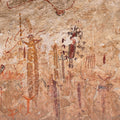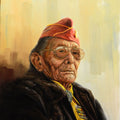IAIA's Native Artist Files receiving support through Hauser & Wirth Institute grant
By Medicine Man Gallery on

IAIA campus view | Photo Credit IAIA
The Institute of American Indian Art’s efforts toward modernizing its voluminous Native Artist Files received a boost through receipt of a Hauser & Wirth Institute grant announced in November. The support will primarily be used in hiring an additional archivist to reappraise and reorganize the Files according to IAIA Archivist Ryan Flahive.
What are now the Native Artist Files were initiated by longtime IAIA Museum Director and Museum Studies faculty member Charles A. Dailey in 1971. Dailey tasked students with adding whatever materials could be found on contemporary Indigenous artists — slides, news clippings, advertisements. Material was aggregated into each individual artist’s file of which there are more than 4,000 today. Resumes, correspondence, gallery guides – a fascinating mélange of source material, hundreds of thousands of items related to artists legendary and obscure. Together, it comprises the most comprehensive collection of information on Contemporary Native artists.
“The Native Artist Files are used by students, curators and other patrons of the archives as a starting point for a deep dive into the artist’s life and work,” Flahive explains. “Oftentimes, secondary sources –books, magazines, journals – do not contain detailed information on an artist required by a research patron. The artist files provide details not found elsewhere. Each provide different research paths for the patron to follow—a name, a gallery, a museum, or the title of an artwork—something to guide them to the next piece of information.”
The incoming archivist will preserve analog materials while simultaneously selecting documents, photographs and other archival items of historical and research value for digital reformatting.
Updating the Native Artist Files continues an effort at IAIA toward streamlining and bolstering online access to the historical record it stewards, which also includes a catalogue of the IAIA Museum of Contemporary Native Arts’ more than 9,000 item permanent collection and the IAIA Archival holdings, another massive body of documents detailing not only the activities of significant artists, but also arts advocates.
IAIA’s goal is unifying all of this material, the artists and the archives, the artwork along with the research, in a single, searchable, online database. Integrating this material serves a purpose greater than digital uniformity.
“While artistic and scholarly activity are usually treated as separate endeavors within Western philosophical systems, with the intellectual more valued than the creative, within Indigenous knowledge systems, physical ‘making’ is integral to knowledge production,” IAIA Research Center for Contemporary Art Director Laura Evans (Cherokee) explained. “This grant will help us make hidden archival materials available in this new database.”
As the only four-year degree fine arts institution in the world devoted to contemporary Native American and Alaskan Native arts and the birthplace of contemporary Indigenous art – and contemporary Western art – IAIA assumes responsibility for chronicling this history. That’s where the Hauser & Wirth Institute connects to the mission.
Its goals are supporting the preservation and digitization of artists' legacies, aiming to tackle long-standing obstacles to expanding art history.
“While most of the art world's focus is on artworks, it is largely through archives – materials like correspondence, notebooks, photo documentation, source materials – that the histories of artists, movements, markets and activism are told,” Hauser & Wirth Institute Executive Director Lisa Darms said. “Archives preserve alternative histories and always make our understanding of art more complex and nuanced, but if those archives aren't accessible, they can't perform this function. This is why underlying every project that we fund or produce, increasing access is our most fundamental aim.”
The other grant recipients for 2022 in addition to IAIA are the Carolee Schneemann Foundation, the South Side Community Art Center and the Women’s Studio Workshop.
“For most of the period in which archives have been actively collected and preserved by Western institutions, they have primarily been the archives of those already in power – effectively writing entire communities out of the canon,” Darms added. “With our grants we support under-resourced and marginalized communities in making their archives more accessible, on their own terms.”
The IAIA legacy visible to the public is its unbroken 60-year history of producing brilliant Native artists: T.C. Cannon, Earl Biss, Kevin Red Star, Doug Hyde, Dan Namingha, Roxanne Swentzell, Rose Simpson, Kathleen Wall, Anita Fields, Tony Abeyta, Cara Romero, Diego Romero, David Bradley, Del Curfman, Cannupa Hanska Luger and on, and on, and on. They’re out front in the museums and the galleries. Away from public view, IAIA upholds another crucial legacy, the documentation and storytelling behind the artists. Each is incomplete without the other.

Researching Archives at IAIA | Photo Credit IAIA



